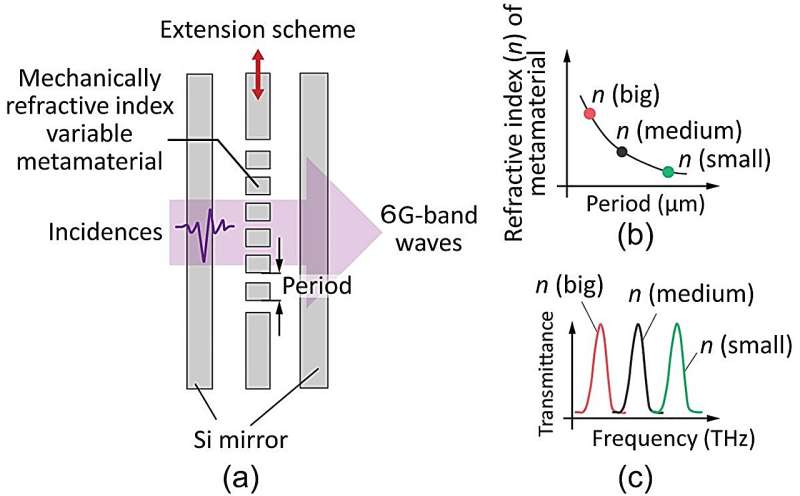This article has been reviewed according to Science X's editorial process and policies. Editors have highlighted the following attributes while ensuring the content's credibility:
fact-checked
trusted source
proofread
New type of tunable filter reveals the potential for terahertz wireless communications

Electromagnetic waves in the terahertz frequency range offer many advantages for communications and advanced applications in scanning and imaging, but realizing their potential poses challenges. Researchers at Tohoku University have addressed one of the key challenges by developing a new type of tunable filter for signals in the terahertz wave band. They published their work in the journal Optics Letters.
Terahertz waves occupy a region of the electromagnetic spectrum between microwave and infrared frequencies. They have a higher frequency (shorter wavelength) than radio waves but a lower frequency than visible light. The increasingly congested radio wave spectrum carries the vast amount of data transmitted by WiFi, Bluetooth, and current mobile phone (cellphone) communications systems.
The congestion of signals in lower frequency parts of the electromagnetic spectrum is one incentive for exploring the options in the terahertz region. Another is the capacity to support ultra-high data transmission rates. A key challenge to using terahertz signals for routine application, however, is to be able to tune and filter the signals at specific frequencies. Filtering is required to avoid interference from signals outside of the desired frequency band.
"We have constructed and demonstrated a frequency-tunable filter for terahertz waves, which achieved a higher transmission rate and better signal quality than conventional systems, revealing the potential for terahertz wireless communications," says Yoshiaki Kanamori of the Tohoku team. He adds that the work could also be more widely applied outside of the terahertz frequency band.
The new terahertz filter is based on a device called a Fabry-Perot interferometer, which, like all interferometers, relies on the interference patterns created when different waves of electromagnetic radiation interact with each other as they bounce between mirrors. The researchers' version uses finely structured gratings, with gaps smaller than the wavelength of the interacting waves, as the material between the mirrors.
Variable stretching of the gratings allows the fine control of their refractive index necessary to tune the interferometer's filtering effect. This allows only the desired frequency to be transmitted. Using different gratings allows control over different selected frequency ranges.
The team has demonstrated their system's application for frequencies suitable for the next-generation (6G) mobile phone signals.
"In addition to our method's application in communications systems, we also envisage uses in scanning and imaging technologies in medicine and industry," Kanamori says.
One advantage of terahertz waves in scanning and imaging is that they can readily penetrate materials, including biological tissues, that block the passage of light. In addition to medical applications, this can offer opportunities for materials analysis, security systems, and quality control in manufacturing.
"Overall, our work offers a simple and cost-effective method to filter and actively control terahertz waves, which could advance their use in many applications," Kanamori concludes.
More information: Ying Huang et al, Tunable Fabry–Perot interferometer operated in the terahertz range based on an effective refractive index control using pitch-variable subwavelength gratings, Optics Letters (2024). DOI: 10.1364/OL.515504
Provided by Tohoku University




















